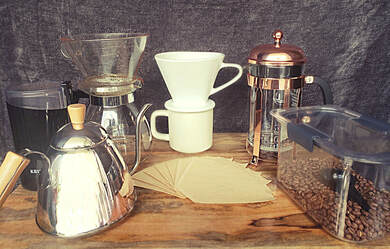Starting from ground zero grounds? Here are all the things you need to start brewing coffee at home.4/19/2020  Alright, first thing’s first - a disclaimer that this is not for the pros, but it’s not for the pod people, either. It’s what I’d call an intermediate coffee brewing style. But, this guide is meant to help those who consider themselves beginners (or even pod converts - AKA Keurig, Nespresso, Verismo) and want to take their coffee game to the next level. While millions are sheltering in place or social distancing, it’s likely your coffee routine has been affected. If you’re up for the task, now’s the time to become self-reliant for all your coffee needs, and start brewing coffee yourself (tech and barista-free)! First, you need to decide what method of brewing is right for you. The list is endless on the number of ways you can brew coffee, and I lazily share the below poster I own demonstrating JUST how many ways exist. Boiling it down, here are the most common/popular home coffee-brewing methods:
For the sake of ease, personal recommendation and concision, I’ll be guiding you through everything you need to start brewing coffee at home via pour over. (...) Let’s start with the equipment you’ll need:
1. A grinder There are three types of grinders: Blade, Burr and Manual. The best bang for your buck will be a blade grinder, but if you’ve got the cash, opt for a Burr, for sure! Main difference? Burr grinders will produce a consistent grind, every time. Blade grinders are tough to produce a serving of ground coffee with a consistent grind throughout, but they get the job done and take up a lot less room! Manual grinders: I wouldn’t go there. Sue me. Why the Burr? Coffee passes through the blades from one chamber to another, which creates the consistent grind of your choice. Recommended Burr: Baratza Encore Conical Recommended Blade: Krups Grinder 2. Coffee-brewing method If you’re taking the pour over route (which I recommend), you need a cone and filter. A lot of people don’t realize there are options other than paper filters, but there are! You can have a plastic, metal or ceramic cone. A metal cone likely means it’s a mesh filter, duplicating the French press filter. Many coffee connoisseurs like French presses/metal filters because there is essentially less of a filter. The oils can filter through mesh but largely get left behind on paper. For a plastic or ceramic cone, be sure to use unbleached paper filters, or reusable hemp/cloth filters. The filter number represents the size of your cone, so be sure to get the right size (see here for a guide). I personally use a ceramic cone filter with three small holes. Holes/hole size is largely overlooked, but this is a minute detail with a tremendous effect. The size and number of holes in the bottom of a cone helps determine the speed and evenness of your coffee’s brew. One large hole can create a weaker cup, and two tiny holes can create a stronger cup. I prefer the happy medium of three small holes. Evenly distributed along the bottom of the cone, it makes a consistently balanced cup of coffee. The final, very important piece of equipment is a gooseneck pour over kettle. Named for it’s curvy spout, a gooseneck kettle is the quintessence of precision. It’s a small, unfussy piece of equipment that completely enhances the coffee (and coffee-making) experience. Once you use it, you’ll never want to make coffee without it again. Some people like electric gooseneck kettles, but I’d only recommend that (as necessary) if you don’t have a gas stove for an old-fashioned stovetop kettle. Recommended Pour Over: Reusable Mesh Pour Over Recommended Gooseneck: SULIVES Built-in Thermometer Wood Handle Recommended Filters: Reusable Organic Hemp Filters Recommended Stovetop Kettle: Pinky Up Presley Tea Kettle 3. Measuring equipment A scale and a scoop are all you’ll need, here. Any kitchen scale will do - don’t feel the need to buy some of the expensive coffee-specific scales. A scale is a scale, as long as it’s versatile in units of measurement. As for the scoop - a scoop is a scoop. If you’re got a scale you don’t need a specific scoop size. Just be sure it stays clean (I keep it in the same container as the coffee) and wash it between new coffees. I prefer a stainless steel scoop, to absorb less oil than plastic or wood. Recommended Scale: GreaterGoods Digital Scale Recommended Scoop: 1 TBS Stainless Steel Scoop 4. Whole bean storage The four enemies of coffee are: light, oxygen, moisture and heat. Thus the ideal coffee storage option is an opaque, air-tight container stored in a dry, room-temperature space. I keep all my coffee things together, so I store my gear, mugs and beans all in an upper-level cabinet away from the stove/oven. Recommended Coffee Storage: Planetary Design Airscape Container That’s it! With a few purchases and personal choices, you’re well on your way to becoming an at-home barista. For starters, defer to your coffee brand of choice’s guidance on brew ratio (most abide by 1:17 coffee to water grams ratio) if it’s mentioned on their site (ex: Stumptown). An entirely separate blog post could detail how to make the perfect pour over, so I won’t get into that today (it’s also highly opinion-based). For now, the great coffee companies have resources galore, at your service (Blue Bottle, Stumptown, Counter Culture). Cheers to high standards and hot coffee! ☕ *Note: This post contains affiliate links. If you purchase from these links I may receive a small portion of the profit :)
0 Comments
Leave a Reply. |
AuthorFollow me @autumn.enoch 📸 CoffeeMateCoffeeMate is your utilitarian guide to LA coffee shops, dedicated to amplifying small businesses.
CoffeeMate also provides product reviews, lists, 101s and more. My ratings scale is as follows: (5) Balanced (4) Strong (3) Bitter (2) Weak (1) Stale Categories
All
|

 RSS Feed
RSS Feed